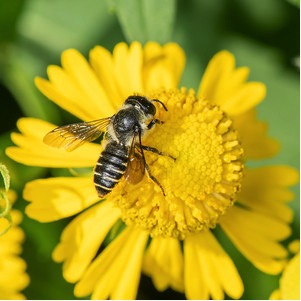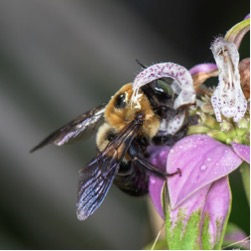
Never doubt that a small group of thoughtful, committed citizens can change the world. Indeed, it is the only thing that ever has. Margaret Mead
It’s official! Media Borough has been certified as a Bee City by the Xerces Society for Invertebrate Conservation, thanks to the dedicated work of Linda Coulston, a member of Transition Town Media’s Biodiversity Group.
Bee City USA, an initiative of the Xerces Society, provides guidelines for communities to protect native bees. Now that we are a Bee City, we are required to provide bees with healthy habitat that is rich in a variety of native plants, nesting sites, and protection from pesticides. Protecting native bees will also help other pollinators, including butterflies and moths.
What do you think of when you hear the word bee? Bee stings and honey bees, I’ll bet. Here’s an interesting fact you may not be aware of: native bees rarely sting unless their nests are disturbed and even then some won’t sting. Some native bees don’t even have stingers.
Honey bees are the bees that will sting. They are not native—they’re European imports. Yes, honey bees pollinate crops, but they’re not the only game in town. Native bees also pollinate crops. In fact, native bees do it better.
Why native bees are important


Bumblebees, carpenter bees, leafcutter bees, sweat bees, mason bees, longhorn bees, mining bees and other native bees can be found in native plant gardens, performing their pollinating magic. Without native bees, we wouldn’t have native plants. Some native bees, called specialist bees, can only use nectar and pollen from a specific native plant. Without those plants, specialist bees can’t survive.
But native plants are not the only plants pollinated by native bees. I’ll bet you didn’t know native bees are responsible for pollinating one third of our food. According to Cornell University, native bees are two to three times better pollinators than honeybees. United States crop pollination value is approximately $18 and $27 billion a year. That’s a lot of pollinator value! So saving our native bees is ensuring that you have food on your table.
The Problem
The United States is home to over 3,600 native bees. Unfortunately, native bee populations are declining in our country as well as globally. Up to 40% of pollinator species on earth are at risk of extinction as a result of habitat loss, pesticide use, and climate crisis. Our pollinators need our help to survive.
The Solution
Approximately 300 towns and cities all over the country have joined Bee City USA to protect native bees. Colleges and Universities are joining Bee Campus USA. The following is a quote from Bee City USA and Bee Campus USA:
While a single person or small group can create immense change, they can only do so with the support of others. Creating pollinator habitat and reducing pesticide use in your own yard or neighborhood park is a great place to start, but to have a significant impact you must inspire others to take similar steps to protect and support pollinators.
Bee City USA encourages us to create change in our own backyards, and then inspire our neighbors to do the same. Transition Town Media’s Biodiversity Group and our Bee City subcommittee is working hard to help bees by offering education to our community, mentoring new gardeners, sharing plants and seeds, writing monthly informational blogs, and offering native plant garden tours. We are following Xerces Society requirements and guidelines to protect native bees.
What you can do
- Learn about bees
- Plant straight species natives!
- Learn which spring blooming native plants are important for Queen bees
- Stop spraying pesticides and herbicides. They kill bees.
- Join our Biodiversity Group/Bee City subcommittee
- Share this information with your neighbors
- Watch this short video to learn more about the Xerces Society
- Join the Xerces Society
Consider volunteering on our Bee City subcommittee. We can stop bee loss with your help.


Leave a Reply